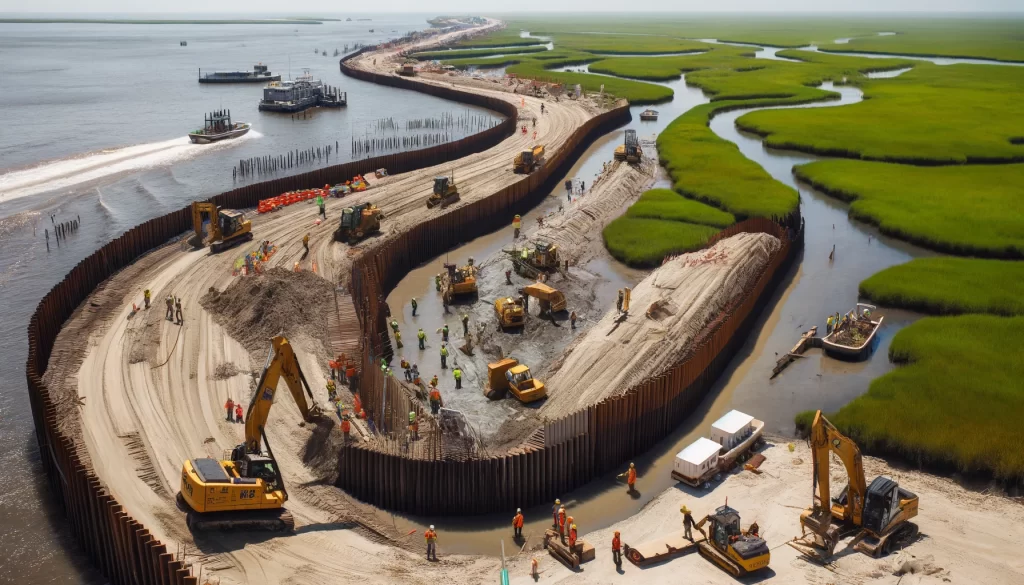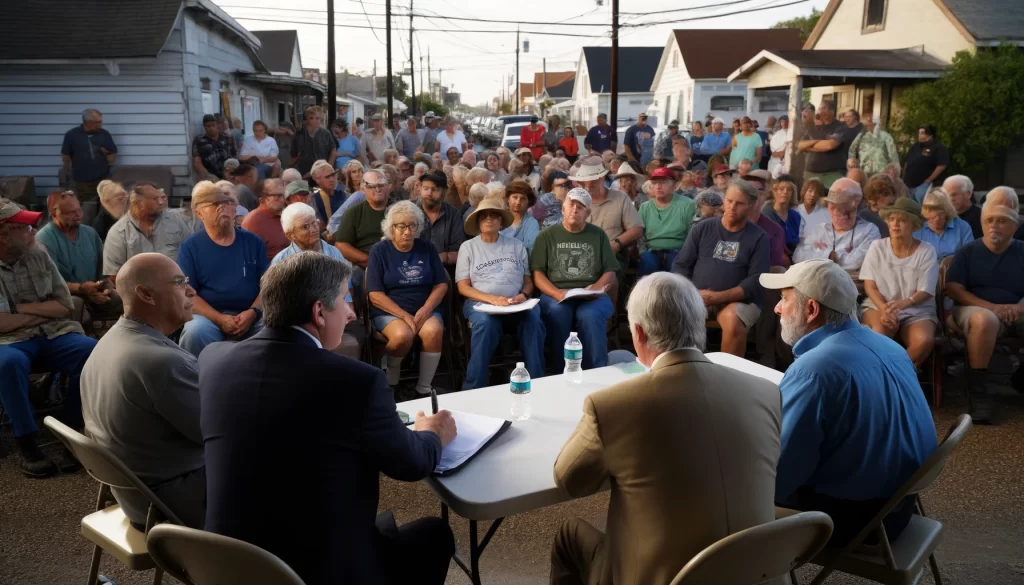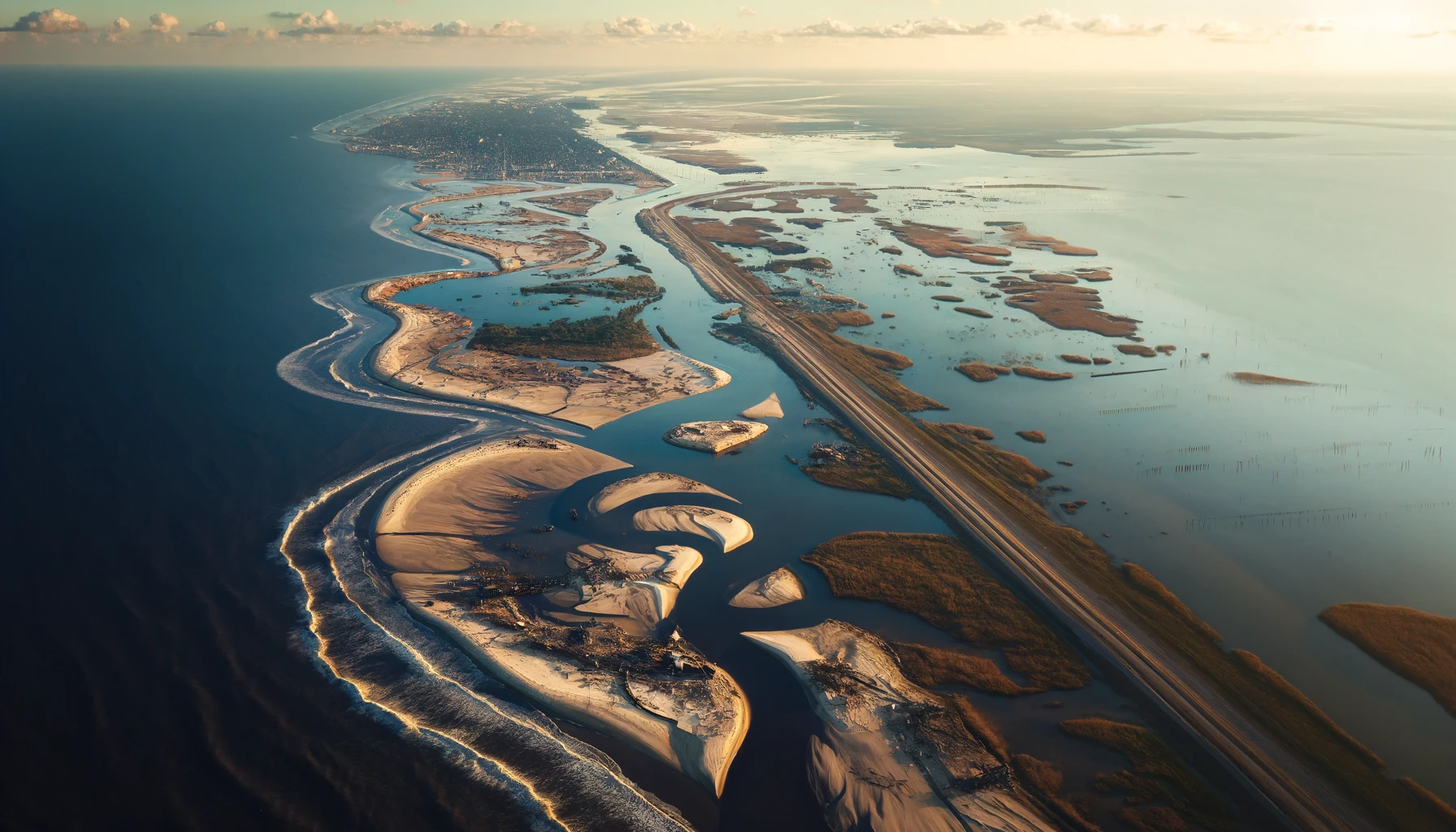Louisiana’s coastline, a vital natural barrier against hurricanes and rising sea levels, is in peril due to recent policy changes introduced by the state’s new Republican governor, Jeff Landry. Despite the state’s Coastal Protection and Restoration Authority (CPRA) being hailed as one of the best in the country, environmental advocates and experts warn that Landry’s actions could significantly undermine its effectiveness.
Over the past decade, following the catastrophic impacts of Hurricanes Katrina and Rita, Louisiana’s CPRA has been instrumental in fortifying coastlines, repairing levees, and preserving natural habitats. The agency has successfully built or refurbished over 300 miles of levees and restored numerous barrier islands, providing essential protection against floodwaters and the pressures of rising seas.
However, Governor Landry’s recent moves have sparked widespread concern. He has removed six members of the CPRA board and proposed integrating the agency into a larger state department, aiming to eliminate operational silos and enhance efficiency. Critics argue that these changes could disrupt the CPRA’s mission, slow down critical projects, and introduce political interference into its operations. Rebecca Triche, executive director of the Louisiana Wildlife Federation, noted that some of the ousted board members brought crucial expertise to the table. “It just appears that independent voices are being removed,” she said.

The CPRA’s importance cannot be overstated, as Louisiana is losing its coastline at an alarming rate. Over the past century, the state has lost more than 2,000 square miles of land and could lose an additional 2,000 square miles in the next 50 years. As sea level rise accelerates, wetlands in many areas are “drowning” – covered by rising water faster than they can grow. Scientists predict that up to 75 percent of the state’s natural buffer against hurricanes and storms could vanish in the coming decades.
The state’s new approach also threatens a crucial project aimed at diverting part of the Mississippi River to restore coastal wetlands in the middle Barataria region, which is sinking faster than 75 percent of all other wetlands in Louisiana. This project, overseen by the CPRA, has been in the works for over a decade but is currently facing legal challenges from Plaquemines Parish, where locals are concerned about the impact of incoming freshwater on fishing. The state’s apparent reluctance to actively defend against this lawsuit has stalled the project, worrying experts who see it as essential to preventing further land loss.
“For the last three administrations, they really haven’t played politics with the coastal restoration agency,” said Christopher Dalbom, a senior research fellow at Tulane University. “They’ve tried really hard to maintain it as a science-based effort.” The lack of progress on the Mississippi River diversion project suggests a shift towards political interference, a departure from the agency’s previously apolitical stance. If the project is halted, nearly $1 billion in investments could be wasted, as highlighted in a recent state Senate hearing.

Louisiana’s situation mirrors a broader trend among right-leaning states, where climate goals and references to climate change are being downplayed or erased. Recently, Florida Governor Ron DeSantis signed a bill removing most mentions of climate change from state law and nullified the state’s targets for 100 percent renewable energy by 2050.
Environmentalists emphasize that maintaining the CPRA’s focus and independence is crucial for Louisiana’s future. The agency’s work is more critical than ever as the state continues to face escalating threats from climate change and sea level rise. “Compared to other states, we have one of the best, deepest coastal restoration authorities in the country,” Dalbom stated. “There’s a real strength there that’s not to be blithely frittered away.”
In an open letter published this week, over 200 business leaders, environmental advocates, and experts warned against Governor Landry’s plans to transform the CPRA. “The very future of our state is at stake,” the letter read, underscoring the gravity of the situation. The letter reflects a growing concern that the governor’s actions could hobble the agency just when its work is most needed.
As Louisiana continues to grapple with its disappearing coastline, the debate over the future of the CPRA and the state’s environmental policies is likely to intensify. Advocates stress that the agency’s efforts to protect and restore the coast must be sustained and strengthened to safeguard Louisiana from the worsening impacts of climate change.
This article is based on the following article:

Background Information
Coastal Erosion and Its Impact
1. Coastal Erosion: Coastal erosion is the process where land along the coast is worn away by natural forces such as waves, tides, and rising sea levels. In Louisiana, this problem is exacerbated by the sinking of land, known as subsidence, and human activities such as oil and gas extraction and the construction of levees and canals. Over the past century, Louisiana has lost more than 2,000 square miles of its coastline, a trend that threatens communities, ecosystems, and economic activities dependent on coastal lands.
2. Sea Level Rise: Global sea levels are rising due to climate change, driven by the melting of polar ice caps and the thermal expansion of seawater as it warms. This rise in sea levels increases the rate of coastal erosion and threatens to submerge low-lying areas. In Louisiana, wetlands, which act as natural buffers against storms and hurricanes, are particularly vulnerable. As these wetlands “drown,” their ability to protect inland areas diminishes.
3. Impact on Communities: Coastal erosion in Louisiana affects homes, businesses, infrastructure, and livelihoods. Many communities depend on the coast for fishing, tourism, and industry. The loss of land and the increased risk of flooding pose significant challenges for residents and policymakers alike.
The Coastal Protection and Restoration Authority (CPRA)
1. Establishment and Role: The CPRA was established in response to the devastation caused by Hurricanes Katrina and Rita in 2005. Its mission is to develop, implement, and enforce a comprehensive coastal protection and restoration plan to safeguard Louisiana’s coast. The agency focuses on building and maintaining levees, restoring barrier islands, and other projects designed to protect against flooding and storm surges.
2. Achievements: Over the past decade, the CPRA has built or revamped over 300 miles of levees and restored numerous barrier islands. These efforts have been critical in mitigating the effects of hurricanes and rising seas, making Louisiana’s coast more resilient to future storms.
3. Challenges: The CPRA faces numerous challenges, including funding constraints, political opposition, and the sheer scale of coastal erosion. Despite these obstacles, the agency’s science-based approach has been a model for other states dealing with similar issues.
The Mississippi River Diversion Project
1. Purpose: The Mississippi River diversion project aims to restore coastal wetlands by diverting sediment-rich water from the river into eroding areas. This sediment helps rebuild land that is being lost to erosion and sea level rise.
2. Importance: Wetlands are crucial for absorbing storm surges and providing habitats for wildlife. By diverting sediment from the Mississippi River, the project seeks to counteract land loss in one of the most rapidly sinking regions, middle Barataria.
3. Controversy: While the project promises significant environmental benefits, it faces opposition from local communities concerned about the impact on fishing and other activities. Legal challenges have stalled the project, raising fears that it may not proceed as planned.
Climate Policy in the United States
1. National and State-Level Policies: Climate policy in the United States is shaped by both federal and state governments. States like Louisiana and Florida, which are highly vulnerable to the impacts of climate change, have developed specific plans to address issues such as coastal erosion, sea level rise, and renewable energy.
2. Political Shifts: Recent political shifts have seen some states, particularly those with right-leaning governments, rolling back climate initiatives. For example, Florida Governor Ron DeSantis recently signed a bill removing most mentions of climate change from state law and nullified the state’s renewable energy targets.3. Implications for Louisiana: Governor Jeff Landry’s policy changes reflect a broader trend of reducing climate action at the state level. These changes have significant implications for agencies like the CPRA, which rely on science-based approaches to address environmental challenges.

Debate/Essay Questions
- To what extent should scientific expertise guide environmental policy decisions?
- What are the potential long-term impacts of rolling back climate change initiatives, as seen in states like Florida, on local ecosystems and communities?
Please subscribe to Insight Fortnight, our biweekly newsletter!
